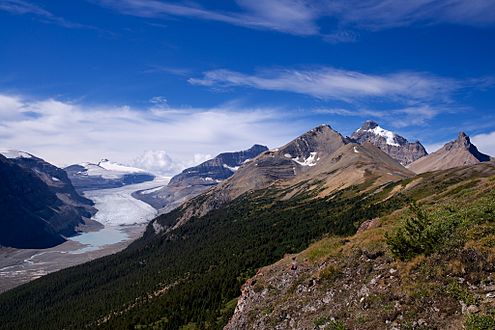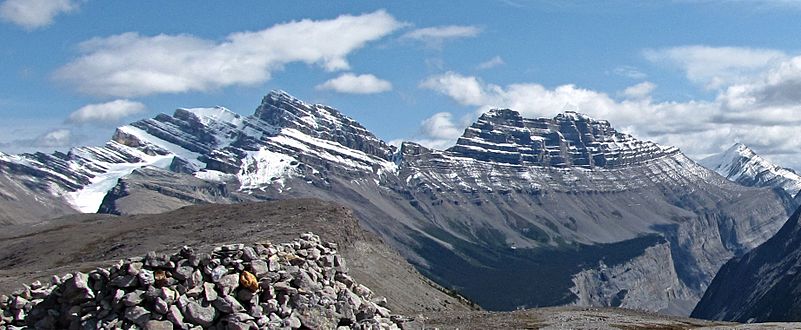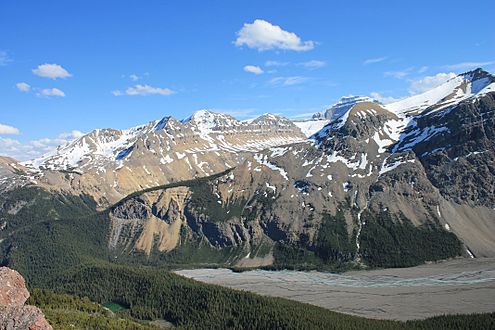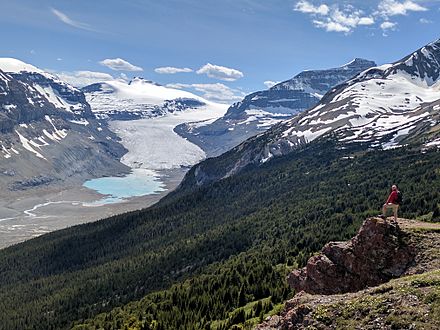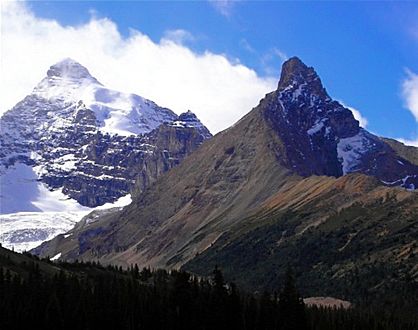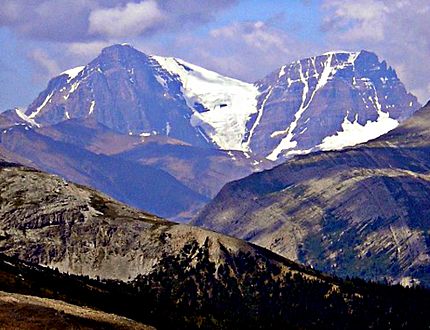Parker Ridge facts for kids
Quick facts for kids Parker Ridge |
|
|---|---|

Parker Ridge viewed from Icefields Parkway
|
|
| Highest point | |
| Elevation | 2,255 m (7,398 ft) |
| Prominence | 170 m (560 ft) |
| Parent peak | Mount Athabasca (3491 m) |
| Geography | |
| Location | Alberta, Canada |
| Parent range | Canadian Rockies |
| Topo map | NTS 83C/03 |
| Type of rock | Sedimentary |
| Climbing | |
| Easiest route | Hiking |
Parker Ridge is a cool mountain ridge in Banff National Park, Alberta, Canada. It stands tall at 2,255-metre (7,398-foot) (about 7,398 feet) and is part of the amazing Canadian Rockies. You can find it near the famous Icefields Parkway, which makes it super easy to visit!
This ridge is a favorite spot for adventurers. In winter, people love to ski-tour here, and in summer, it's a popular place for hiking. Why? Because it's right next to the Icefields Parkway, so it's easy to get to. Plus, most of the ridge is above the treeline, which means you get incredible, wide-open views of the mountains all around.
Parker Ridge is located in the upper North Saskatchewan River valley. Its closest taller neighbor is Mount Athabasca, which is about 7.7 km (4.8 mi) (4.8 miles) to the west. Parker Ridge sits along the west side of the Icefields Parkway, just southeast of Sunwapta Pass.
If you hike the trail, it's about 2.2 km (1.4 mi) (1.4 miles) long. You'll climb about 275 metres (900 ft) (902 feet) from the highway to the top of the ridge. Once you're up there, you can walk along the ridge to see awesome sights like Cirrus Mountain, the north side of Mount Saskatchewan, and the huge Saskatchewan Glacier. You can also spot Mount Athabasca, Hilda Peak, and Nigel Peak.
History of Parker Ridge
Parker Ridge was named after a special person: Elizabeth Parker (1856–1944). She was a journalist who helped start the Alpine Club of Canada in 1906, along with Arthur Oliver Wheeler. This club helps people explore and enjoy the mountains safely.
There's even a cabin called the Elizabeth Parker hut near Lake O'Hara that is also named in her honor. The name "Parker Ridge" was officially recognized in 1978 by the Geographical Names Board of Canada.
How Parker Ridge Was Formed
Just like other mountains in Banff Park, Parker Ridge is made of a type of rock called sedimentary rock. This rock formed a very, very long time ago, from the Precambrian to Jurassic periods. Imagine shallow seas covering this area! Over millions of years, layers of sand, mud, and tiny bits of sea creatures settled and hardened into rock.
Later, during a huge event called the Laramide orogeny, these rock layers were pushed and folded. They were even pushed east and over the top of younger rocks, creating the mountains we see today, including Parker Ridge.
Climate Around Parker Ridge
Parker Ridge has a subarctic climate. This means it has very cold and snowy winters, but the summers are mild. In winter, temperatures can drop below -20 °C (-4 °F). With the wind, it can feel even colder, sometimes below -30 °C (-22 °F)!
When snow melts or it rains on Parker Ridge, the water flows into small streams. These streams eventually join larger rivers, like the North Saskatchewan River.
Gallery
Views from Parker Ridge
-
Saskatchewan Glacier and Castleguard Mountain
-
Mount Athabasca and Hilda Peak from Parker Ridge trail




